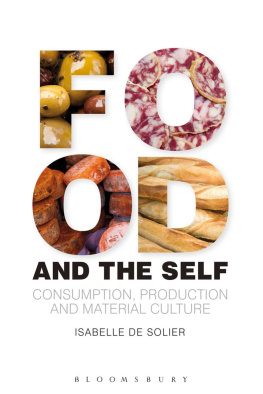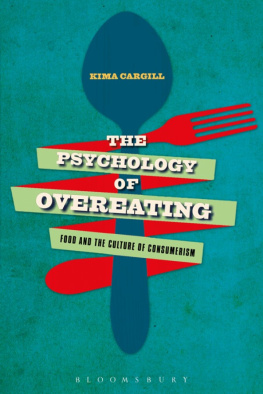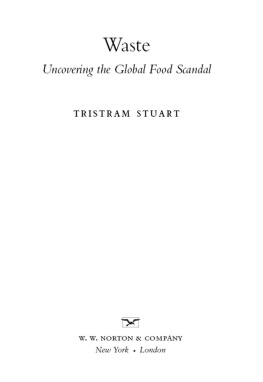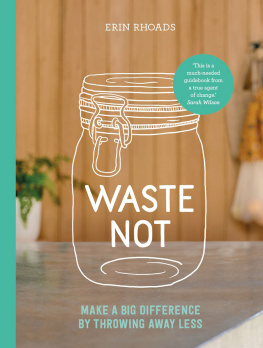Food Waste
Materializing Culture
Series Editors: Paul Gilroy and Daniel Miller
Barbara Bender, Stonehenge: Making Space
Gen Doy, Materializing Art History
Laura Rival (ed.), The Social Life of Trees: Anthropological Perspectives on Tree Symbolism
Victor Buchli, An Archaeology of Socialism
Marius Kwint, Christopher Breward and Jeremy Aynsley (eds), Material Memories: Design and Evocation
Penny Van Esterik, Materializing Thailand
Michael Bull, Sounding Out the City: Personal Stereos and the Management of Everyday Life
Anne Massey, Hollywood Beyond the Screen: Design and Material Culture
Wendy Joy Darby, Landscape and Identity: Geographies of Nation and Class in England
Joy Hendry, The Orient Strikes Back: A Global View of Cultural Display
Judy Attfield, Wild Things: The Material Culture of Everyday Life
Daniel Miller (ed.), Car Cultures
Elizabeth Edwards, Raw Histories: Photographs, Anthropology and Museums
David E. Sutton, Remembrance of Repasts: An Anthropology of Food and Memory
Eleana Yalouri, The Acropolis: Global Fame, Local Claim
Elizabeth Hallam and Jenny Hockey, Death, Memory and Material Culture
Sharon Macdonald, Behind the Scenes at the Science Museum
Elaine Lally, At Home With Computers
Susanne Kchler, Malanggan: Art, Memory and Sacrifice
Nicky Gregson and Louise Crewe, Second-Hand Cultures
Merl Storr, Latex and Lingerie
Lynn Meskell, Object Worlds in Ancient Egypt: Material Biographies Past and Present
Sophie Woodward, Why Women Wear What They Wear
Daniel Miller (ed.), Anthropology and the Individual: A Material Culture Perspective
Inge Daniels, The Japanese House: Material Culture in the Modern Home
Isabelle De Solier, Food and the Self: Production, Consumption and Material Culture
Magdalena Craciun, Material Culture and Authenticity: Fake Branded Fashion in Europe
This book is concerned with how and why households end up wasting food that they have purchased for consumption. As such, its premise is relatively straightforward: to explore how stuff that is understood as food eventually becomes waste. I am going to begin with a story about broccoli and this story begins in the supermarket. However unlike traces broccoli back from the supermarket to the Mayan farmers in highland Guatemala who produced it, and in doing so offers a powerful analysis of globalization, desire and political economic relations of power; I am going to take an altogether more familiar journey. My story simply follows the broccoli back from the supermarket, into somebodys home and eventually their bin.
BROCCOLI
And so this story begins in the supermarket, where Sadie has graciously allowed me to join her as she goes about the task of doing her grocery shopping. Sadie is in her early forties and lives with her husband and two young children. Both she and her husband are busy, professional workers who tend to share responsibility for cooking, however Sadie is responsible for the vast majority of food shopping. As we walk around the fruit and vegetable aisles in the supermarket, she picks up a broccoli head and explains to me that this is an item of food that gets wasted a lot in their household as it is rare for them to eat all that they buy. When she has finished explaining this to me, she places the broccoli in her shopping trolley. It is curious that as somebody who is in fact deeply troubled by the act of wasting thisor indeed anyfood, she continues to purchase it when it is likely that she will end up placing it in the bin. I point this out to her and it leads to a discussion about the importance of buying broccoli on the grounds that it is healthy and one of those things that you are supposed to eat. Still standing in the vegetable aisle, Sadie picks the broccoli out of the trolley and elaborates that by looking at it, you can tell that it is fresh, wholesome and good for you. Actually, it transpires, it is not just her health that she is thinking about hereit is the health of her husband and children. It goes back in the trolley and we carry on shopping.
Three days later, I am in Sadies kitchen where she has invited me to accompany and observe her as she prepares an evening meal for her family. Roughly half of the broccoli florets are getting steamed along with some carrots and cauliflower, forming an accompaniment to some new potatoes and salmon baked with lemon juice, parsley and a small amount of garlic. It smells really good. The remainder of the broccoli floretsalong with about the same amount of cauliflower and what is left of the bag of carrotsgets wrapped up and placed back in the fridge. Incidentally, although edible, the stalk of the broccoli is not something that Sadie (in common with much of the U.K. population) considers as food and so it does not register as, or feature in, her understandings of food waste. The following week I am once again in Sadies kitchen following a trip to the supermarket, and she is putting away the shopping that she has just acquired. As part of this process she needs to make some room in the fridge. This involves re-organizing some of the items that are in there, but it also involves throwing things out. Of interest here is that the leftover broccoli remains uneaten and by now, it does not look quite so fresh, enticing and wholesome. In fact it looks rather limp, feels a bit soft and appears to have suffered a degree of discoloration. As a result, it becomes a casualty of this sorting out process and ends up in the bin, whichas will be seenmeans that it will most likely be carried off into the waste stream.
So items that were once understood as food have now been configured as waste, and effectively this happened when a newer, fresher, counterpart was acquired. You might be thinking well why purchase new broccoli in the first place? however the analysis that follows suggests that there are many reasons for doing so and that, certainly, the activity of feeding the family (before its eventual fate was acknowledged. However in keeping it around for a while, processes of physical decay conspire to position the old broccoli as unsuitable for ingestion, or at least less suitable than the new arrival. In turn, this helps to legitimize its consignment to the category of waste and the act of binning it. True enough, it did not reach the point at which it was unsafe to eat but to salvage it would have risked the future of the good broccoli that had just been purchased.
Of course, it could have been eaten at some point in between placing it in the fridge and eventually placing it in the bin. However, again, there are many valid and understandable reasons why this did not happen. For example, Sadies children will only eat broccoli in combination with baked salmon and she does not wish to cook this more than once a week in case they get bored of it and then refuse to eat broccoli at all. Additionally, Sadie would happily buy the broccoli in a smaller quantity; however, she does not have the option of doing so because the supermarket only sells whole broccoli heads. You might be thinking that perhaps she does not need to buy broccoli







